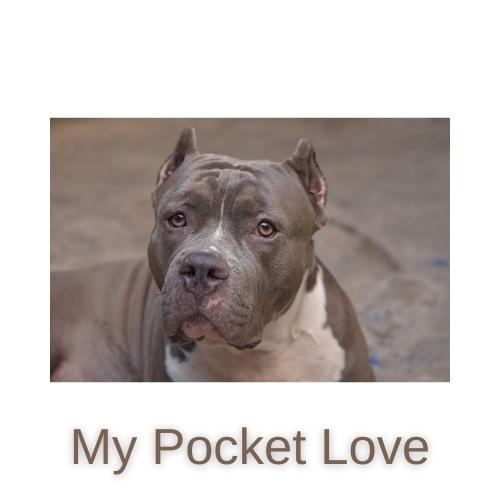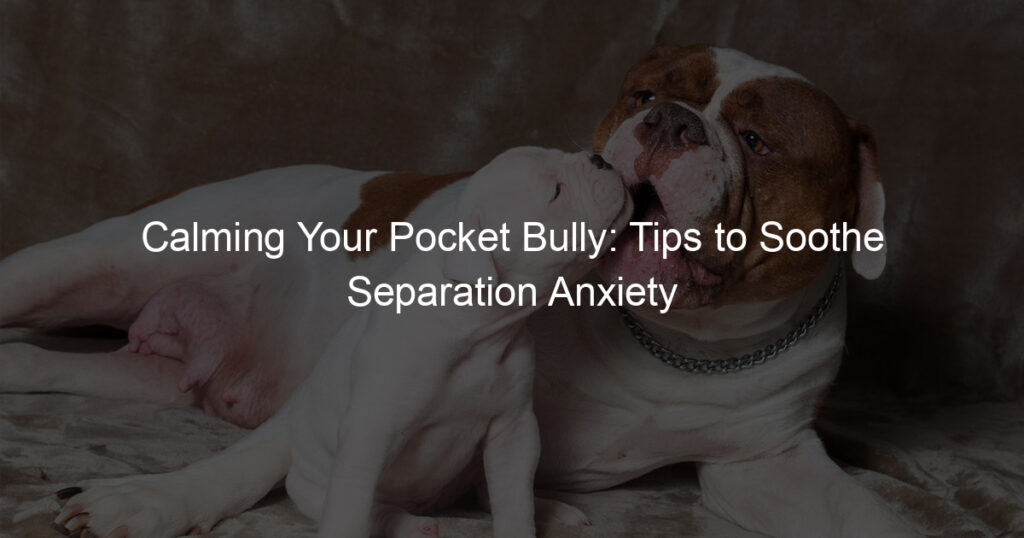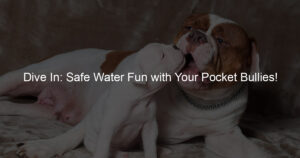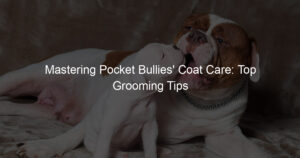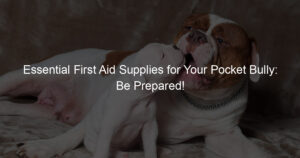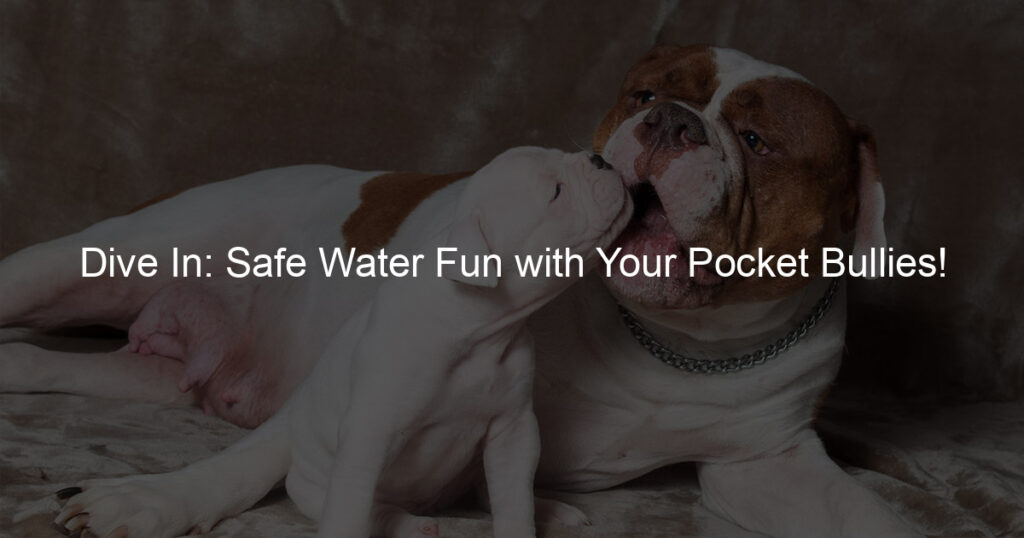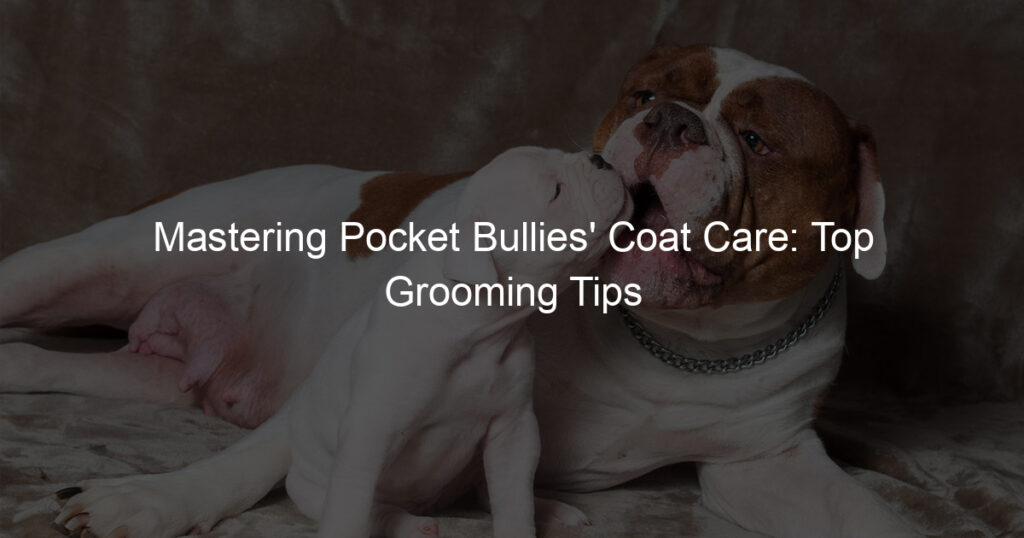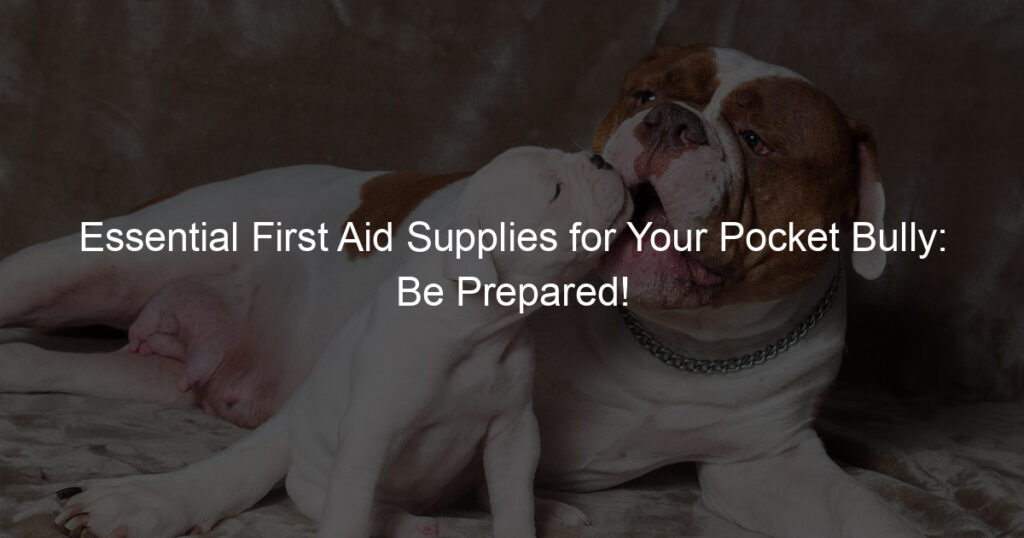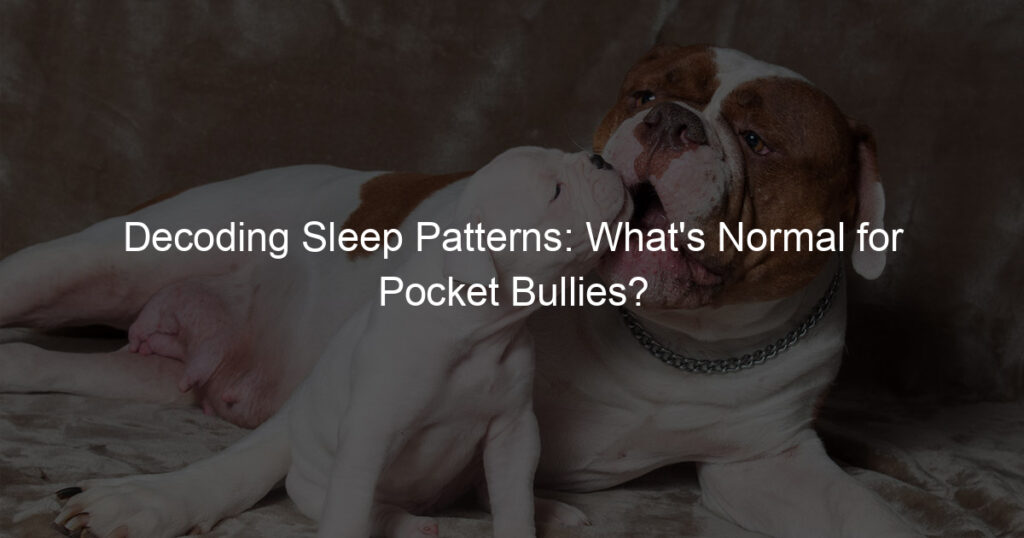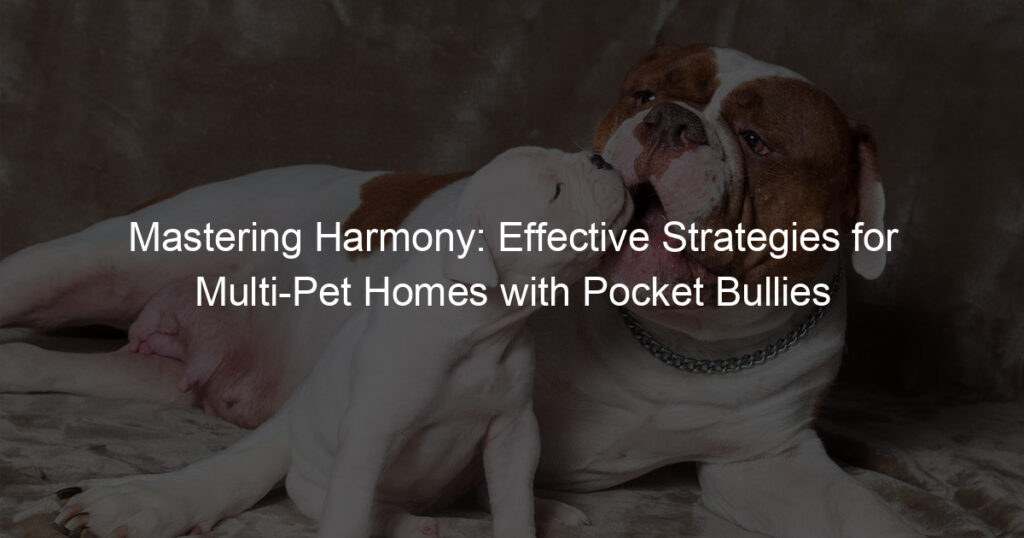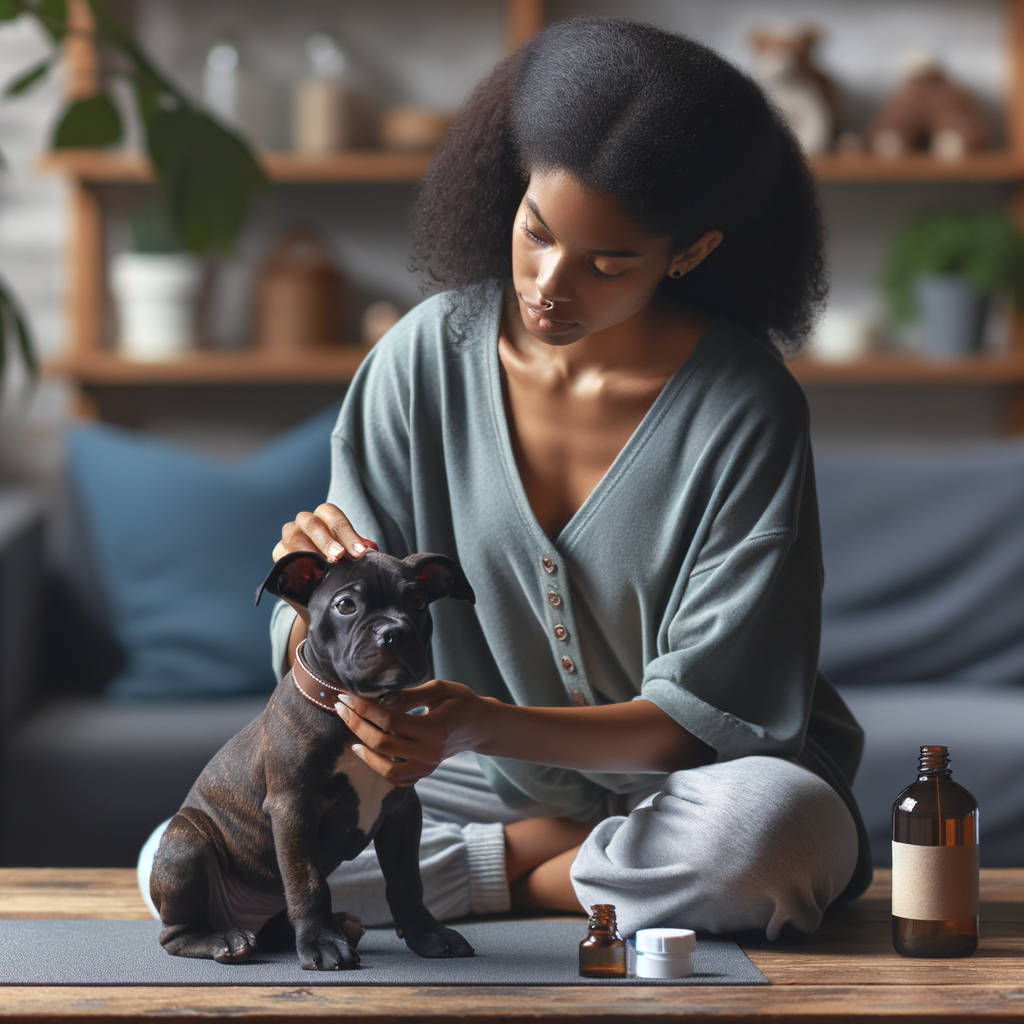
Introduction to Separation Anxiety in Pocket Bullies
Separation anxiety is a common issue faced by many dog breeds, including Pocket Bullies. This condition can cause your furry friend to feel stressed and anxious when left alone. Understanding their behavior and identifying the signs of separation anxiety can help you provide the best care for your Pocket Bully.
- Understanding Pocket Bullies behavior
- Identifying signs of separation anxiety in Pocket Bullies
- Excessive barking or howling when left alone
- Chewing, digging, or other destructive behavior
- Pacing or restlessness
- Accidents in the house despite being house trained
- Excessive salivation or drooling
Pocket Bullies, like other dog breeds, are social animals. They thrive on companionship and interaction with their human families. They are known for their loyalty and affectionate nature, which makes them great family pets. However, this strong bond can also make them prone to separation anxiety when left alone.
It’s important to remember that Pocket Bullies are not naturally anxious dogs. Their anxiety is often a result of certain situations or experiences, such as a change in routine or environment. Understanding your Pocket Bully’s behavior can help you identify any changes that may indicate they are feeling anxious.
Separation anxiety in Pocket Bullies can manifest in various ways. Some common signs include:
If you notice any of these signs, it’s important to consult with a veterinarian or a professional dog trainer. They can provide guidance on how to manage your Pocket Bully’s separation anxiety and improve their overall well-being.
In the following sections, we will delve deeper into the strategies for easing anxiety in dogs, specific techniques for managing separation anxiety, and the importance of mental health in Pocket Bullies. Stay tuned for more helpful tips on how to ensure a happy and healthy life for your Pocket Bully.
Easing Anxiety in Dogs: General Tips
Dealing with an anxious dog can be a challenging task. However, there are several general tips that can help ease your dog’s anxiety. These include regular exercise, creating a safe space, and maintaining a consistent routine. Let’s delve into these points in more detail.
- Importance of Regular Exercise
Exercise is not just crucial for your dog’s physical health, but it also plays a significant role in their mental well-being. Regular exercise helps burn off excess energy, which can reduce anxiety levels. A study conducted by the University of Bristol found that dogs who had at least one hour of exercise per day showed fewer signs of anxiety compared to those who had less.
- Creating a Safe Space
Every dog needs a safe, comfortable space where they can retreat when they’re feeling anxious. This could be a specific room, a crate, or even a comfortable bed in a quiet corner. The key is to make this space as calm and inviting as possible. You can add their favorite toys, blankets, or even play soothing music. Remember, this space should be a sanctuary for your dog where they can feel secure and relaxed.
- Consistent Routine
Dogs thrive on routine. A consistent daily schedule can significantly reduce anxiety in dogs. This includes regular feeding times, walks, playtime, and bedtime. A study by the Journal of Veterinary Behavior found that dogs with a consistent daily routine showed fewer signs of anxiety and stress. So, try to stick to a schedule as much as possible. Even small changes can make a big difference in your dog’s anxiety levels.
In conclusion, easing anxiety in dogs requires patience, understanding, and consistency. By incorporating regular exercise, creating a safe space, and maintaining a consistent routine, you can help your dog feel more secure and less anxious. Remember, every dog is unique, so it’s important to find what works best for your furry friend.
Managing Separation Anxiety in Dogs: Specific Techniques
Separation anxiety in dogs can be a challenging issue to handle. However, there are several specific techniques that can be employed to manage this condition effectively. Here are three of the most effective methods:
- Gradual Desensitization
- Counter-conditioning
- Medication as a Last Resort
Gradual desensitization is a technique that involves slowly getting your dog used to being alone. This process starts with leaving your dog alone for short periods and gradually increasing the time. It’s like teaching a child to swim by starting in the shallow end of the pool. This method can be very effective, but it requires patience and consistency.
Counter-conditioning is a process where you change your dog’s emotional response to being alone. Instead of feeling anxious, they learn to associate being alone with positive experiences. For example, you might give your dog a special treat or toy that they only get when you’re gone. This method can be very effective, but it requires consistency and a good understanding of your dog’s likes and dislikes.
If the above methods are not effective, medication can be considered as a last resort. There are several types of medication that can help manage separation anxiety in dogs. However, it’s important to remember that medication should always be used in conjunction with behavioral techniques and under the guidance of a veterinarian. Medication alone won’t solve the problem, but it can help make the other techniques more effective.
Remember, every dog is unique, and what works for one might not work for another. It’s important to be patient and persistent, and to seek professional help if needed. With the right approach, separation anxiety can be managed effectively, leading to a happier and healthier life for your dog.
Case Study: Successful Management of Separation Anxiety in a Pocket Bully
- Background of the case
Meet Bella, a two-year-old Pocket Bully. Bella’s owners noticed that she was showing signs of distress whenever they left the house. She would bark excessively, chew on furniture, and even have accidents in the house. After consulting with a veterinarian, Bella was diagnosed with separation anxiety.
- Techniques used
Bella’s owners, with the help of a professional dog trainer, implemented a two-pronged approach to manage her separation anxiety. This included:
- Gradual Desensitization: Bella was gradually exposed to being alone for short periods, which were then slowly increased over time.
- Counter-Conditioning: Bella was trained to associate being alone with positive experiences. For example, she was given her favorite treat or toy when her owners were about to leave the house.
Medication was considered as a last resort, but Bella responded well to the training techniques, so it was not needed.
- Results and key takeaways
After several weeks of consistent training, Bella’s separation anxiety significantly decreased. She no longer exhibited destructive behavior when left alone and seemed much happier and relaxed. The key takeaway from Bella’s case is that with patience, consistency, and the right techniques, separation anxiety in Pocket Bullies can be successfully managed.
Before Training After Training Destructive behavior No destructive behavior Excessive barking Minimal barking Accidents in the house No accidents
Pocket Bullies Training: Preventing Separation Anxiety
Training your Pocket Bully to prevent separation anxiety is a crucial part of their overall well-being. It involves early socialization and specific training methods aimed at reducing anxiety. Let’s explore these strategies in more detail.
- Early Socialization
Early socialization is a vital aspect of your Pocket Bully’s training. It involves exposing your puppy to a variety of people, environments, and other animals from a young age. This helps them become comfortable with different situations and reduces their likelihood of experiencing anxiety when left alone.
For instance, you can take your Pocket Bully to the park, pet stores, or on walks around the neighborhood. This exposure helps them understand that the world is not a scary place, and they can feel safe even when you’re not around. Remember, the key is to make these experiences positive and fun for your puppy.
- Training Methods to Prevent Anxiety
There are several training methods you can use to help prevent separation anxiety in your Pocket Bully. These include:
- Gradual Desensitization: This involves slowly getting your dog used to being alone. Start by leaving them alone for just a few minutes at a time, and gradually increase the duration. Always reward your dog for staying calm during these periods.
- Counter-Conditioning: This technique involves changing your dog’s emotional response to being alone. For example, you can give your dog a special treat or toy that they only get when you’re gone. This can help them associate your absence with something positive.
- Obedience Training: Teaching your dog basic commands like ‘sit’, ‘stay’, and ‘down’ can help them feel more secure. It also gives them something to focus on other than their anxiety.
Remember, every dog is unique and what works for one may not work for another. It’s important to be patient and consistent with your training. If your Pocket Bully continues to struggle with separation anxiety, don’t hesitate to seek help from a professional dog trainer or behaviorist.
Pocket Bullies Mental Health: Importance and Maintenance
Just like humans, dogs, specifically Pocket Bullies, also have mental health needs. It is crucial to understand and maintain their mental health to ensure they live a happy and fulfilling life. This section will delve into understanding the emotional needs of Pocket Bullies and how to maintain their mental health through stimulation and companionship.
- Understanding the Emotional Needs of Pocket Bullies
Pocket Bullies, like all dogs, are emotional beings. They experience joy, fear, love, and anxiety, much like humans. They also have a strong desire for companionship, as they are pack animals by nature. Understanding these emotional needs is the first step towards maintaining their mental health.
For instance, Pocket Bullies are known for their loyalty and affection towards their owners. They thrive on positive reinforcement and consistent training. They also need a safe and secure environment to feel comfortable. Any sudden changes in their routine or environment can cause them distress, leading to behavioral issues. Therefore, it is essential to provide them with a stable and loving environment.
- Maintaining Mental Health Through Stimulation and Companionship
Keeping your Pocket Bully mentally stimulated is a key aspect of maintaining their mental health. This can be achieved through regular exercise, playtime, and training sessions. These activities not only keep them physically fit but also mentally sharp. They help in reducing anxiety and stress, promoting overall mental well-being.
Companionship is another crucial factor in maintaining a Pocket Bully’s mental health. As mentioned earlier, these dogs are pack animals and thrive in the company of their human family or other pets. Spending quality time with your Pocket Bully, showing them love and affection, can greatly enhance their mental health.
In conclusion, understanding and catering to the emotional needs of your Pocket Bully, along with providing them with adequate stimulation and companionship, can go a long way in maintaining their mental health. Remember, a happy and mentally healthy dog is a joy to have around.
Coping with Dog Separation Anxiety: Owner’s Guide
Dealing with a pet’s separation anxiety can be a challenging task for any dog owner. It’s important to remember that you’re not alone in this journey, and there are ways to manage the situation effectively. This guide will provide you with self-care tips and advice on when to seek professional help.
- Self-care tips for owners
- Stay calm: Dogs can pick up on your stress and anxiety. Try to remain calm and composed, especially when leaving or returning home.
- Establish a routine: Dogs thrive on routine. Consistency can help reduce your pet’s anxiety.
- Take care of your health: Regular exercise, a balanced diet, and sufficient sleep can help you stay resilient in stressful situations.
- Connect with other dog owners: Sharing experiences and tips with other owners can provide emotional support and practical advice.
- Seeking professional help when needed
- Escalating symptoms: If your dog’s anxiety symptoms are getting worse despite your efforts, it’s time to consult a professional.
- Physical harm: If your dog is causing physical harm to themselves or damaging property, professional help is necessary.
- Impact on your wellbeing: If managing your dog’s anxiety is causing significant stress or affecting your mental health, seek professional assistance.
As a dog owner, your wellbeing is just as important as your pet’s. Here are some tips to help you cope with the stress of managing your dog’s separation anxiety:
If your dog’s separation anxiety is severe and you’re feeling overwhelmed, it may be time to seek professional help. Here are some signs that professional intervention may be needed:
Remember, there’s no shame in seeking help. You’re doing the best you can for your pet, and sometimes that means reaching out to professionals. With the right support, both you and your dog can navigate the challenges of separation anxiety successfully.
Pocket Bullies Care: Ensuring a Happy and Healthy Life
Providing the best care for your Pocket Bullies is essential to ensure they lead a happy and healthy life. This involves a combination of a balanced diet, regular vet check-ups, and plenty of love and affection. Let’s delve into these aspects in more detail.
- Diet and Nutrition
- Regular Vet Check-ups
- Importance of Love and Affection
Feeding your Pocket Bullies a balanced and nutritious diet is crucial for their overall health. This breed needs a diet rich in proteins, carbohydrates, and healthy fats. Proteins help in muscle development, carbohydrates provide energy, and fats contribute to a shiny coat and healthy skin. Make sure to include fruits and vegetables in their diet as they are packed with essential vitamins and minerals. Always choose high-quality dog food that is free from artificial additives and fillers. Remember, the nutritional needs of your Pocket Bullies may change as they age, so it’s important to consult with your vet for the best dietary advice.
Regular vet check-ups are a must to keep your Pocket Bullies in the best of health. These check-ups can help detect any potential health issues early, making them easier to treat. Your vet can also provide vaccinations, dental care, and advice on preventing parasites. It’s recommended to have at least one vet visit per year, but puppies and older dogs may need more frequent check-ups.
Love and affection play a significant role in the overall well-being of your Pocket Bullies. This breed thrives on human companionship and can become anxious if left alone for long periods. Regular playtime, walks, and cuddles can help strengthen your bond with your pet and keep them happy. Remember, a happy dog is a healthy dog!
In conclusion, taking care of your Pocket Bullies involves more than just meeting their physical needs. It’s about creating a loving environment where they feel safe and secure. So, shower them with love, feed them a balanced diet, and ensure regular vet check-ups to keep them in the best of health.
Treatments for Separation Anxiety in Pocket Bullies: An Overview
Separation anxiety in Pocket Bullies can be a challenging issue to tackle. However, with the right approach and treatment, it can be managed effectively. This section will provide an overview of the various treatments available, including behavioral therapies, medications, and natural remedies.
- Behavioral Therapies
- Medications
- Natural Remedies
Behavioral therapies are often the first line of treatment for separation anxiety in Pocket Bullies. These therapies aim to modify the dog’s behavior and response to being left alone. They may involve desensitization techniques, where the dog is gradually exposed to being alone for longer periods, and counter-conditioning, which involves changing the dog’s emotional response to being alone.
In some cases, medication may be necessary to manage severe symptoms of separation anxiety. These medications can help to reduce anxiety and promote calmness in your Pocket Bully. However, they should always be used under the guidance of a veterinarian, and they are typically used in conjunction with behavioral therapies.
Natural remedies can also be effective in managing separation anxiety in Pocket Bullies. These may include herbal supplements, aromatherapy, or calming wraps. It’s important to note that while these remedies can be helpful, they should not replace a comprehensive treatment plan that includes behavioral therapy and potentially medication.
In conclusion, treating separation anxiety in Pocket Bullies requires a multi-faceted approach. It’s important to work with a professional, such as a veterinarian or a certified animal behaviorist, to develop a treatment plan that’s tailored to your dog’s specific needs. Remember, every dog is unique, and what works for one may not work for another.
